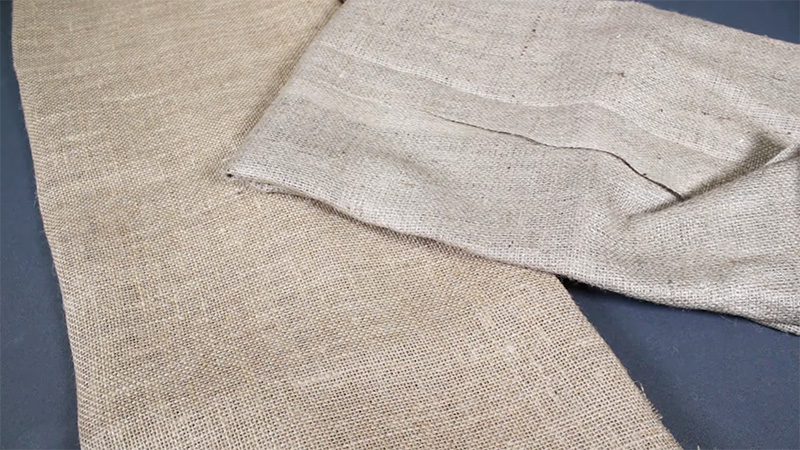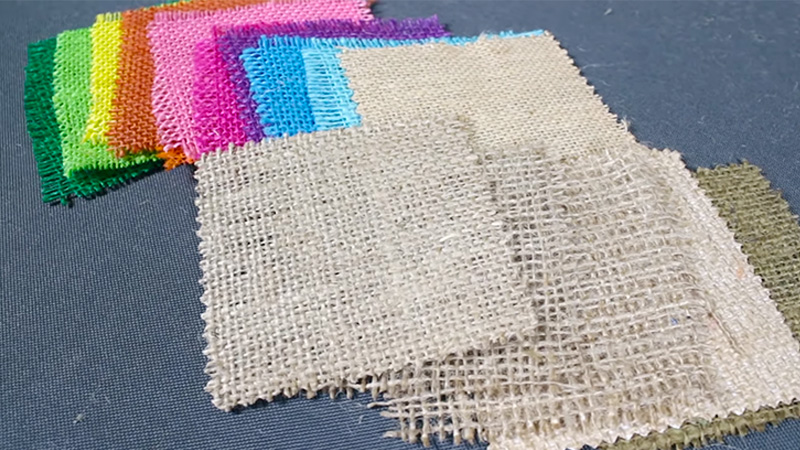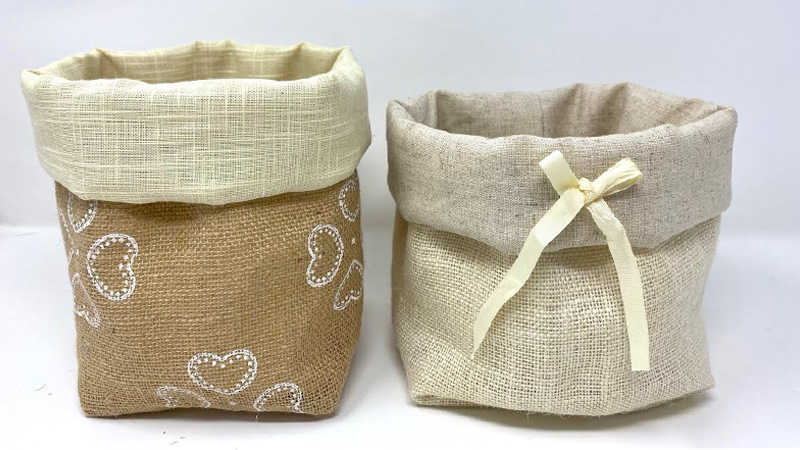Hessian fabric, also known as burlap in some regions, is a textile material that has a rich history and a wide range of applications. Its coarse, loosely woven texture sets it apart from more refined fabrics, making it a unique and valuable choice in various industries.
In this exploration of what is hessian fabric – types & uses, we will delve into its types and versatile uses. Hessian fabric is traditionally made from jute fibers, offering natural breathability and durability.
The types of hessian fabric vary in terms of weave density, thickness, and weight, making them suitable for different tasks. From heavy-duty sacking material to lighter, more decorative options, each type serves a distinct purpose.
The applications of hessian fabric span a broad spectrum, ranging from agriculture and construction to arts and crafts. Its robustness makes it a preferred choice for packaging, while its rustic charm lends itself well to creative projects.

What Is Hessian Fabric?
Hessian fabric, also known as burlap in some regions, is a type of woven textile material. It is typically made from the fibers of the jute plant, although synthetic versions are also available.
Hessian fabric is known for its coarse and loosely woven texture, which sets it apart from finer textiles. The characteristics of hessian fabric, such as its breathability, durability, and natural appearance, make it suitable for a variety of applications.
Types of Hessian Fabric

Hessian fabric comes in various types, each tailored to specific purposes and preferences. Here are some common types of hessian fabric:
Standard Hessian
This is the most common type of hessian fabric, typically made from natural jute fibers. It has a coarse texture and is often used in agricultural packaging, such as sacks for storing grains and potatoes.
Lightweight Hessian
As the name suggests, this type of hessian fabric is lighter in weight and has a finer weave compared to standard hessian. It is often used in crafts, DIY projects, and for decorative purposes like table runners and home decor.
Colored Hessian and Fire-Retardant Hessian
Hessian fabric can be dyed in various colors, expanding its decorative possibilities. Colored hessian is often used in arts and crafts, event decor, and themed projects.
In applications where fire safety is a concern, fire-retardant hessian is used. It has been treated with fire-resistant chemicals to reduce its flammability.
Laminated Hessian and Scented Hessian
Laminated hessian has a layer of plastic or another material applied to one side. This makes it waterproof and more suitable for outdoor applications like garden covers or temporary shelter.
Some variations of hessian fabric are infused with scents or fragrances. These are commonly used in potpourri sachets or air fresheners.
Biodegradable Hessian
In line with growing environmental concerns, biodegradable hessian is gaining popularity. It’s designed to break down naturally over time, making it a sustainable choice for certain applications.
Synthetic Hessian
While traditional hessian is made from jute, synthetic hessian can be crafted from materials like polypropylene. Synthetic hessian offers durability and is resistant to moisture, making it suitable for various industrial and outdoor uses.
Each type of hessian fabric has its unique characteristics, making it suitable for specific tasks or creative projects. Choosing the right type depends on the intended application and the desired properties, such as strength, texture, or color.
Uses of Hessian Fabric

From agriculture and construction to crafts and interior decor, the coarse and loosely woven Hessian fabric finds its way into numerous aspects of our daily lives.
In this comprehensive exploration, we will delve into the diverse and innovative applications of hessian fabric.
Agricultural Packaging
Hessian fabric’s strength and breathability make it an ideal choice for agricultural packaging. It is commonly used for making sacks and bags for storing grains, potatoes, coffee beans, and other agricultural products.
Its breathable nature allows air circulation, helping to prevent spoilage and maintain product quality.
Erosion Control
In the realm of environmental conservation, hessian fabric plays a crucial role in erosion control. It is used to stabilize soil and prevent erosion on construction sites, riverbanks, and hillsides.
The fabric’s natural texture allows it to hold soil in place while allowing water to permeate, aiding in soil protection and regeneration.
Construction
Hessian fabric is utilized in various construction applications. It is commonly employed as a scaffold covering, offering protection to workers and materials.
Additionally, it is used as a curing blanket for concrete, helping to maintain proper moisture levels during the curing process. Hessian’s durability ensures it can withstand the rigors of construction sites.
Arts and Crafts
Craft enthusiasts appreciate hessian fabric for its rustic appearance and versatility. It is used in a wide range of DIY projects, including making decorative items like table runners, placemats, and coasters.
The fabric’s natural texture provides a unique and charming aesthetic that suits a variety of crafting styles.
Interior Decor
Hessian fabric adds a touch of rustic charm to interior decor. It can be used for creating curtains, throw pillow covers, and wall hangings.
Its neutral color complements various design themes, from farmhouse to bohemian, and its durability ensures that these decorative elements withstand the test of time.
Upholstery Support
In upholstery, hessian fabric often serves as a base layer. It provides strength and support to the underlying padding and cushions, helping to maintain the shape and structure of furniture. The fabric’s sturdiness makes it a reliable choice for this purpose.
Gardening
Gardeners use hessian fabric for a multitude of purposes. It can be used to create protective covers for plants during frosty weather or to create shade structures to shield delicate plants from harsh sunlight.
Hessian is also employed as a weed barrier, preventing unwanted growth while allowing water and nutrients to reach the soil.
Fashion and Accessories
Occasionally, fashion designers incorporate hessian fabric into clothing and accessories. It can be used to create unique garments, bags, hats, and even shoes. Its rough texture can add an element of texture and contrast to fashion pieces.
Event Decor
Hessian fabric is a popular choice for event decor, particularly for rustic-themed weddings and parties. It can be used as table runners, chair sashes, and even as backdrop material for photo booths. Its natural, textured appearance adds warmth and character to event spaces.
Cushioning and Padding
In addition to its role in upholstery, hessian fabric can be used as cushioning or padding material in various applications. For example, it can be used to create mattress toppers or as a layer in seat cushions, offering support and comfort.
Art and Painting
Hessian fabric serves as a unique canvas for artists. Its texture adds depth and interest to paintings and can be used as a background material for mixed-media artworks. Some artists also use hessian as a stencil material for creating textured patterns in their work.
Bookbinding
Bookbinders use hessian fabric for book covers, offering a textured and durable surface. It adds a tactile quality to books and can be found in vintage or handcrafted bookbinding projects.
Hessian fabric’s versatility, natural appeal, and eco-friendly nature, especially when made from jute, make it a valuable material in various industries and creative endeavors.
Packaging, Wrapping, and Decor
Beyond agriculture, hessian fabric is utilized in various packaging and wrapping applications. It can be used to wrap gifts, adding a rustic touch to presents for special occasions. Additionally, it is used in the shipping industry to protect fragile items during transit.
Hessian fabric is employed in outdoor decor as well. It can be used to create banners, flags, and other outdoor signage. Its resistance to the elements and ability to accept paint or printing make it a versatile choice for outdoor applications.
Costume Design and Soundproofing
Costume designers often use hessian fabric for creating costumes, particularly for theater productions or historical reenactments. Its texture and durability make it suitable for crafting costumes that require a rustic or vintage appearance.
In some acoustic applications, hessian fabric is used as part of soundproofing solutions. It can be incorporated into wall panels or acoustic curtains to help absorb sound and reduce echo in spaces.
Geotextiles and DIY Home Projects
Hessian fabric is used as a geotextile material in civil engineering and construction projects. It can be applied as a separating and filtering layer in road construction and drainage systems.
DIY enthusiasts often turn to hessian fabric for various home improvement projects. Whether it’s creating unique lampshades, reupholstering chairs, or making wall art, hessian provides an attractive and practical solution.
Pet Care and Education
Some pet owners use hessian fabric to craft pet accessories like beds, toys, and scratching posts. Its durability can withstand the wear and tear of pets, making it a suitable choice for these items.
Hessian fabric is used in educational settings as a tactile aid for sensory and motor skills development in children. Its textured surface can be part of sensory exploration activities.
FAQs
What is the difference between hessian fabric and burlap?
Hessian fabric and burlap are essentially the same material but may have different regional names. In the United States and Canada, it’s commonly referred to as “burlap,” while in many other parts of the world, it’s known as “hessian.”
Is hessian fabric eco-friendly?
Yes, hessian fabric is considered eco-friendly, especially when made from jute fibers. Jute is a sustainable plant that requires minimal pesticides and water to grow. Additionally, hessian is biodegradable, which means it naturally decomposes over time, reducing its environmental impact.
Can hessian fabric be used outdoors?
Yes, hessian fabric can be used outdoors, but its durability depends on the specific type of hessian. Laminated or synthetic hessian is better suited for outdoor applications as it is more resistant to moisture and the elements.
How do I care for hessian fabric items?
Hessian fabric items should be handled with care. To clean, gently spot clean with mild soap and water. Avoid excessive moisture, as it can cause the fabric to weaken or develop mold. Keep hessian items away from direct sunlight.
Can hessian fabric be dyed or painted?
Yes, hessian fabric can be dyed or painted to achieve different colors and patterns. Fabric dyes or acrylic paints work well for this purpose. Keep in mind that hessian’s coarse texture may absorb more dye or paint than smoother fabrics, so you may need to use more dye or paint.
Conclusion
Hessian fabric, with its rough-hewn allure and adaptability, stands as a testament to the enduring appeal of natural textiles. As we’ve explored its various types and uses, it becomes clear that this unassuming material plays a significant role in numerous industries and creative endeavors.
From the practicality of heavy-duty hessian in agriculture and construction to the aesthetic appeal it brings to home décor and artistic pursuits, hessian fabric has proven its worth time and again.
As we continue to seek versatile materials that bridge the gap between function and aesthetics, hessian fabric remains a steadfast contender. Its timeless charm and rugged reliability ensure that it will continue to find its place in our lives.
Whether it’s wrapping up a precious gift or adding character to a living space, hessian fabric is a reminder that simplicity and versatility can be woven into the fabric of modern living.
Leave a Reply